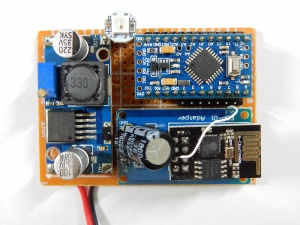IoT with AME: Difference between revisions
Jump to navigation
Jump to search
No edit summary |
No edit summary |
||
| Line 4: | Line 4: | ||
* [[MQTT]] - A protocol for connecting IoT devices | * [[MQTT]] - A protocol for connecting IoT devices | ||
* [[ | * [[Software Stack|Software for building IoT devices]]: PubSubClient, Client-adapter, ESP8266 (out in the open) or, alternatively, AC_IOT, AC_MQTT, ACP_TCPESP8266, and AC_ESP8266 (my own stack) | ||
* [[ | * [[Software Problems]]: SoftwareSerial, memory use, debugging | ||
* [[ | * [[Hardware Stack|Hardware for building IoT devices]]: Arduino, ESP8266, additional hardware | ||
* [[Hardware Problems]]: Current spikes, flaky ESP8266 behavior | |||
* [[Pitfalls]] - Things that can go wrong, and how to address them | * [[Pitfalls]] - Things that can go wrong, and how to address them | ||
* [[Challenges]] - How to overcome hardware and software limitations | * [[Challenges]] - How to overcome hardware and software limitations | ||
Revision as of 22:50, 14 June 2018
IoT with AME - The Internet of Things, with Arduino, MQTT, and ESP8266
This is work in progress started in June 2017 - I am in the process of typing out my experiences with IoT, Arduino, and ESP8266, as a documentation for myself and as something that might be helpful to others.
- MQTT - A protocol for connecting IoT devices
- Software for building IoT devices: PubSubClient, Client-adapter, ESP8266 (out in the open) or, alternatively, AC_IOT, AC_MQTT, ACP_TCPESP8266, and AC_ESP8266 (my own stack)
- Software Problems: SoftwareSerial, memory use, debugging
- Hardware for building IoT devices: Arduino, ESP8266, additional hardware
- Hardware Problems: Current spikes, flaky ESP8266 behavior
- Pitfalls - Things that can go wrong, and how to address them
- Challenges - How to overcome hardware and software limitations
- Management - How to manage an IoT installation
- My IoT projects - What I built over time
- To Do - What I would like to improve and add in this Wiki
Note to self (help on MediaWiki):
